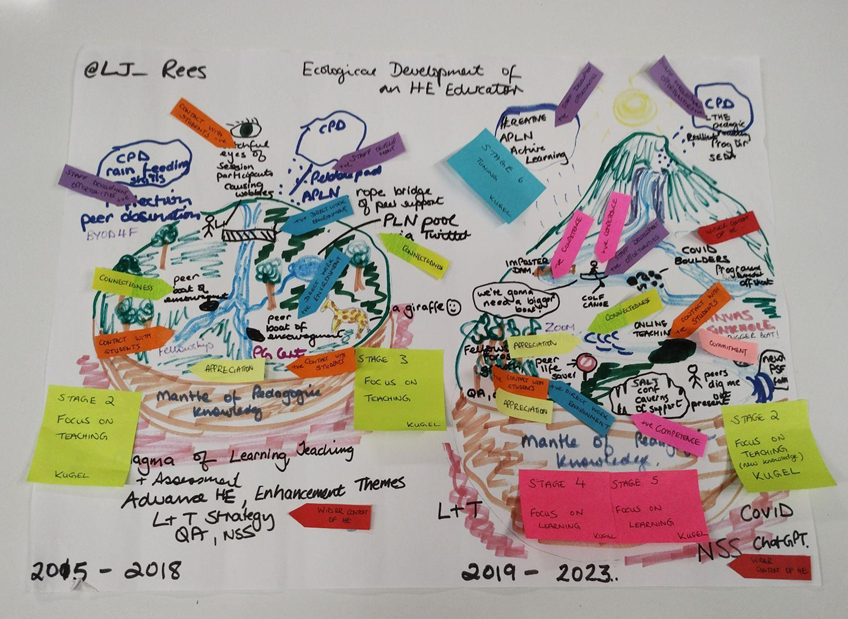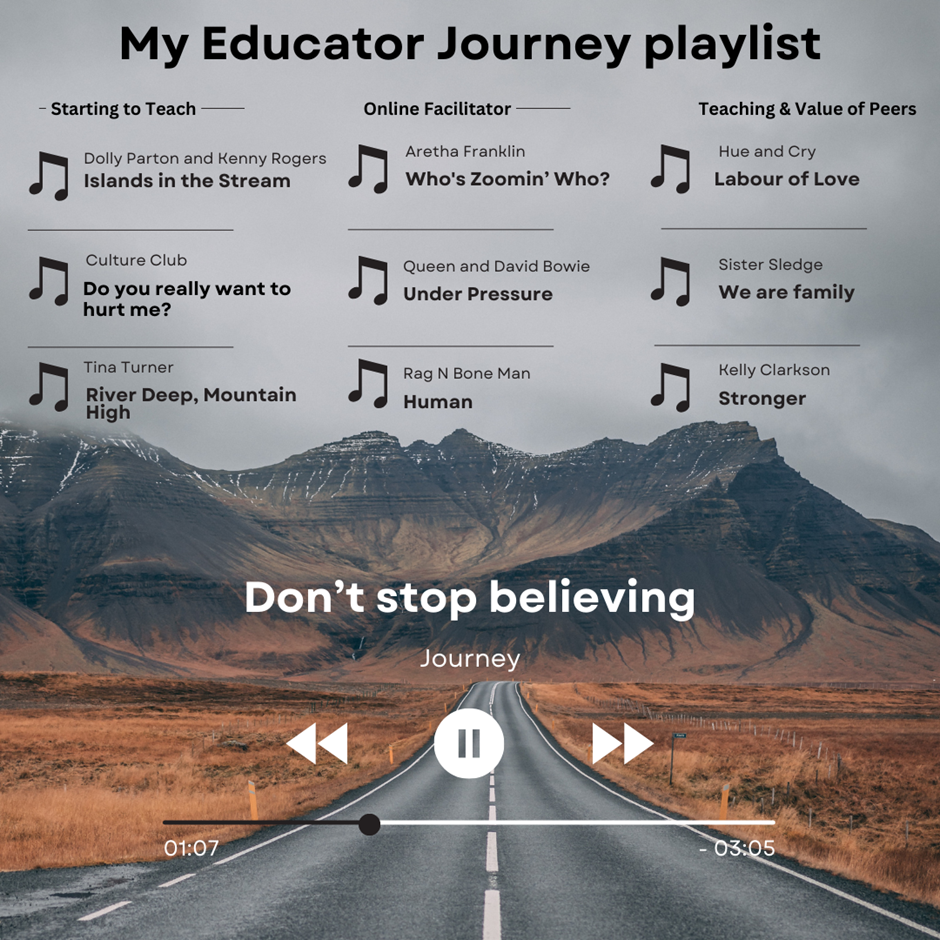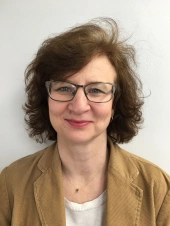
[Image credit: https://pixabay.com/photos/giraffe-drink-dislocate-yoga-1641933/%5D
Led by Louise Rees @LJ_Rees
Introduction
This #LTHEchat post and associated tweetchat aims to explore how you might use non-written ‘creative’ approaches to support reflection on learning and/or as pieces of formative or summative assessment. In particular I’d like to explore issues of degree of comfort, choice, student and facilitator preparation and robustness in marking various creative forms. And I end in a plea for any specific examples of approaches that you’d be willing to share.
Creative approaches to support reflection on learning
First, what is creativity? The Cambridge dictionary defines it as ‘the ability to produce or use original and unusual ideas”. Sir Ken Robinson says creativity is ‘applied imagination’ – the process of having original ideas that have value”. It requires process, originality and determining if the work is any good.
The CreativeHE website notes the goal of its community is to ‘support pedagogical rebels and free-thinking innovators in experimenting with, developing, sharing and getting support for novel learning and teaching ideas’. I have learnt a lot from my rebellious peers in engaging in their sessions!
Given that a more experienced colleague has often told me that there are very few ‘new’ ideas in education – just a rehash of previous concepts and activities – are there any truly creative ideas out there? Ken Robinson recognises that there are few original concepts and ideas – but the important thing is that they might be new to you, your peer group or your participants and so there IS creativity and originality in their application. And you don’t have to be ‘arty’ – scientists exist who apply their intelligence to explore developing products or testing concepts in a new creative way.
Can you teach people to be creative? Well if you view teaching in a strict interpretation as direct instruction on a topic, then probably not. Again referring to Ken Robinson, he reminds us that teaching, and especially in fostering creativity, is about enabling, providing opportunities, encouragement, facilitation and mentoring. Previous LTHEChats on sketchnoting and #CreativeHE sessions have for example adopted exactly that approach and that’s what I tried to adopt in the approach I outline below.
What is reflection?
This blogpost isn’t about the various models about reflection and reflective practice, so I’m going to simply draw on this definition “a deliberate and conscientious process that employs a person’s cognitive, emotional and somatic capacities to mindfully contemplate past, present or future actions in order to learn and to better understand and potentially improve their actions” (Harvey, Coulson and McMaugh, 2016 quoted in the Advance HE (2020) publication authored by Harvey et al in the references at the end.)
Reflection and being a reflective practitioner is key to the development of the practice of an educator at all levels of compulsory, further and higher education. Its often “taught” explicitly within PG Cert programmes and common in professional disciplines such as Medicine, Health Care and Social Work.
Where my ‘creativity’ exploration started
In 2018, I was particularly inspired when one of the programme leaders of a HE fellowship programme shared her use of visual metaphors to help prompt staff to reflect on their teaching philosophy. I incorporated this imagery, along with ‘bring a significant thing – object/picture/music/ etc’ – to the first session of the module I taught on our PG Cert HE where we examine the development of educator identity.
That approach was successful, with many participants finding that being able to visually represent their teaching approach to be quite liberating and guiding for their future development. After a period of CPD learning from peers, I engaged in the international Active Learning Conference in July 2022 where Jamie Heywood from Anglia Ruskin University facilitated a fabulous workshop sharing several creative ways to reflect. I decided to research various approaches, gain examples where I could and incorporate this further into my session.
I offered participants the choice of reflecting on their teacher identity and journey to date using one of the following:
- As a River of Learning
- As an Academic Island (drawn)
- As a Lego representation
- As a sketchnote
- In a reflective poem
- A music/video playlist
- In a timeline/flowchart
- Some other ‘creative’ means
(There are other ‘creative’ approaches such as interpretive dance – see Dance My PhD (Announcing the annual Dance Your Ph.D. contest | Science | AAAS) or slightly tongue in cheek – The Amazing World of Gumball (YouTube; minute 2:00 – 3.30).
The final reflective assignment for the module I teach could use written or non-written approaches (e.g. podcasts, presentation, development of a video, pathwork text using collage, MS Sway etc) and so it seemed at odds to me that I did not use such approaches earlier in the module as preparation.
Scaffolding Learners (and facilitators!) for the creative task
The pattern of synchronous teaching on the module, means that there was no opportunity to practice or provide a session on these approaches so I decided that the production and discussion that ensued would not be assessed.
I had considered asking participants to reflect using only one particular approach. In doing so, it might result in a more ‘consistent’ output for individuals to discuss. However I felt this was not appropriate and not inclusive. Instead, I referred to the original sources for the above ideas (see references) and provided examples for each, where I could. Above all, they needed to choose an approach they were comfortable with, and had the time to complete.
It was important for me to consider how long it might take me to produce my teacher journey using one of these options. I’d previously produced a timeline which I shared in a slidedeck, so I chose the Academic Island concept. (As a geographer this resonated with me, so I represented my ‘educator journey and identity’ through a series of volcanic islands, developing as the tectonic plates shifted and succession of plants took place. I annotated it with reference then to the theories of development which they were encouraged to do AFTER bringing their creative output to the session for discussion. Doing the activity was vital to see how long this would take and if I was expecting them too much and so I shared my output with them, emphasising that I was NOT considering artistic competency – as you can see from below!

[Image credit: Louise Rees, 2023]
As a music lover I could find individual pieces of music that reflected my mood or approach at a particular time, but could not find a music playlist that encompassed my journey without considering issues of inappropriate lyrics later in the song or being limited by my own musical preferences and genres.
The opportunities creative reflective approaches provide
Providing a range of creative approaches that participants can choose addresses issues of inclusion, student choice, fosters deeper, richer reflection (in my experience) and can also address concerns about the authorship that a written reflection might present in the age of AI (because I coupled it with in-class ‘presentation and explanation’ of what the image holds for that individual). Additionally it made it far more interesting for me to look at the variety of what each person produced to tell their story.
Two participants shared their reflection on the activity at our internal conference, and commented that the activity, while initially reluctant to engage with, provided freedom of expression and diversity of approach. They noted it ended up being a relaxing and enjoyable activity, provided a relatability to common issues with peers and for one member of staff, inspiration to apply something similar with her own students.
Some of the pitfalls to consider
After the session, I sought feedback from the cohort and reflected on it as an approach. Here are some of my tips;
- Ensure that you provide time for participants to undertake the activity. Some of this required deep thinking, preparation and sourcing of drawing materials, for example.
- Ensure that you have sufficient examples to use to offer variety, and where possible do as many as you are able. (I was missing some – see my plea below!)
- Consider assigning some marks to completion and participation. I didn’t include this as a piece of formative assessment and only a handful of participants actually included any of their visual output within their written assignment. I wondered if some might entirely adopt a ‘creative’ approach to their final submission, but only a couple did – a podcast and a ThingLink. If marks had been assigned from the start, would they have put more effort into it with the anticipation of developing it for their final submission?
- Be prepared for attendees to NOT have done the activity and think about how you might re-jig any pairings so that at least one person has done something to share. Consider then some ‘back up’ reflective prompt questions for those who haven’t done the pre-session preparation.
- Consider if you have the time to sit with each small group to meaningfully help facilitate their learning and linking to the literature – if that’s a goal later on. I would have liked to have more time with each group.
A plea for musical examples
No-one presented a musical approach. They brought drawings of their development as rivers, islands, a ladder, some ‘sketchnotes’, a timeline and a ‘table’ which they discussed with me moving between groups.
Resulting from the 2022 LTHEChat #232, there is a great playlist reflecting music that was significant for those engaging in the chat that evening which I encourage you to listen to – you may need to sign up for a free Spotify account though!
But as I prepare to teach the module again in 2024, I would like to respond to some of the feedback from the participants by providing more examples. Can you help fill that gap? Have you asked your ‘students’ for a music or video playlist that represents their learning or “journey”? And perhaps this post may inspire to dabble a little bit in ‘creativity’ also.
References & Further Reading / Viewing / Listening
Advance HE (2020) Reflection for Learning guide: Reflection for learning: a scholarly practice guide for educators, (Harvey, M. Lloyd K. McLachlan K. Semple A-L and G Walkerden) https://www.advance-he.ac.uk/knowledge-hub/reflection-learning-scholarly-practice-guide-educators
Attardo G., E. Gillaspy and S. Sinfield (2022) Learning through Music, https://lthechat.com/2022/04/03/lthechat-232-learning-through-music-led-by-attardojoe-egillaspy-danceswithcloud-on-06-april-2022-8pm-bst/
CreativeHE (2022) ‘Let’s Dance! Play that funky music to facilitate learning’ session https://creativehecommunity.wordpress.com/2021/12/10/lets-dance-play-that-funky-music-to-facilitate-learning/
Faulkner S. (2023) Sketchnoting in Education, https://lthechat.com/2023/06/04/lthechat-266-sketchnoting-in-education-with-suzanne-faulkner-sfaulknerpando/ (June 7th, 2023)
Harvey, M, Coulson, D, and McMaugh, A (2016). Towards a theory of the ecology of reflection: reflective practice for experiential learning in higher education. Journal of University Teaching and Learning Practice, 13(2). ro.uow.edu.au/jutlp/vol13/iss2/2
Heywood, J. (2022) Using creative reflection methods to foster active learning, International Active Learning Network Conference, July 2022 https://youtu.be/sUH5yWXud1c?list=PL2iyVL0VLkZUHpnr1e9j7s9fI0j_PD79O
Hinton D. M. (2022) An Island of Academic Identity – A PGCHE Activity, National Teaching Repository, https://figshare.edgehill.ac.uk/articles/educational_resource/PGCHE_Academic_Identity_Activity/21354156?file=37902807
Hinton D.M. (2022) Build your Teaching Philosophy using Lego Serious Play, National Teaching Repository, https://figshare.edgehill.ac.uk/articles/event/Build_your_Teaching_Philosophy_using_Lego_Serious_Play/20290935
Illingworth, S. (2022) Edinburgh Napier University Poetry as a reflective tool, https://www.timeshighereducation.com/campus/learned-words-using-poetry-reflect-practices-higher-education and also https://learnedpoems.wordpress.com/
Robinson K. (2011) Out of our minds: learning to be creative, Wiley & Sons
Robinson K. (2014) Can Creativity be taught? The Brainwaves Video Anthology, https://youtu.be/vlBpDggX3iE YouTube. Accessed November 16 2023.
Rossi V. (2020) Lesson closures (30 min webinar) on Vimeo: https://vimeo.com/418933475 (for the River of Learning concept)
Swanton K. (2022) Sketchnotes, AUA Blog, https://aua.ac.uk/sketchnotes-aua-blog/
Swanton K. (2020) The Academic Benefits of Sketchnoting, National Teaching Repository, https://figshare.edgehill.ac.uk/articles/media/The_Academic_Benefits_of_Sketchnoting/12721598/1
van Lankveld, T., Schoonenboom, J., Volman, M., Croiset, G., & Beishuizen, J. (2017). Developing a teacher identity in the university context: a systematic review of the literature. Higher Education Research and Development, 36(2), 325–342. https://doi.org/10.1080/07294360.2016.1208154
Wiley, C. (2016) Using music creatively to enhance non-music teaching, https://lthechat.com/2016/02/01/lthechat-no-44/
Playlists
Music playlist to Reflect my Educator Journey/Identity

Starting to teach:
- Islands in the stream, Dolly Parton and Kenny Rogers
- Do you really want to hurt me? Culture Club
- River Deep, Mountain High, Tina Turner
Online Facilitator:
- Who’s Zoomin’ Who? Aretha Franklin
- Under Pressure, Queen & David Bowie
- Human, Rag n bone man
Teaching & Value of Peers:
- Labour of love, Hue and Cry
- We are family, Sister Sledge
- Stronger, Kelly Clarkson
Favourite (in the moment):
- Don’t stop believing, Journey
The LongList
Start of my career in facilitating learning in HE
PG student “demonstrator”:
- Islands in the stream, Dolly Parton and Kenny Rogers
- All by myself, Eric Carmen
Initial attempts- Student Feedback:
- Do you really want to hurt me? Culture Club
Start supporting Fellowship applicants and PG cert students
Struggles of using different approaches:
- River Deep, Mountain High, Tina Turner
The impact of a disruptor
COLF, COVID and Zoom:
- Who’s Zoomin’ Who? Aretha Franklin
- Under Pressure, Queen & David Bowie
- Neverending Story, Limahl from Kajagoogoo
Online teaching is part of my identity:
- Don’t Stop me now, Queen
- (Anything you want) You got it, Roy Orbison
- Moving on up, M People
- Just can’t get enough, Depeche Mode
Pressures experienced through teaching online:
- I can’t get no satisfaction, Rolling Stones
- Human, Rag n bone man
- Imposter Syndrome, Abe Parker
The impact of my #PLN – support and collaboration exploring approaches
- Labour of love, Hue and Cry
- Don’t you worry ‘bout a thing, Tori Kelly
- We are family, Sister Sledge
- I’ll be there for you, The Rembrandts
- Lean on me, Bill Withers
Reflecting more recent feedback from my ‘students’
- Good Job, Alicia Keys
- Stronger, Kelly Clarkson
Favourite (in the moment)
- Don’t stop believing, Journey
- Don’t Stop me now, Queen
Learning from other educators
Motivational Playlist:
A soundtrack for a growth mindset: https://open.spotify.com/playlist/0riU0rKBbPNi9TX5Kk52oz?si=a4NPU8kwTKKR3Qeh3xkU3Q
A calm classroom playlist:
Calm Classroom Soundtrack – playlist by Aimee’s Edventures | Spotify
Soundtrack for the classroom:
A soundtrack to reflect and write to
music to write & reflect to – playlist by Alabaster Co | Spotify
Examples of Creative Approaches Shared in Response to Q6 of LTHEChat # 277
VirnaRossi (@VirnaRossi)
I’ve tried sooo many different ways… including drama, poetry, collage, LEGO, drawing, Padlet
For my next PGCert cohort, I’d like to make a reflective photobook, let’s see how it goes
Sarah Honeychurch (@NomadWarMachine)
We are currently putting together our SoTL advent calendar blog, and we asked authors to choose a song to represent their attitudes to #SoTL # LTHEChat
Santanu Vasant (@SantanuVasant)
A6 Mention of Music, reminded me of #LTHEChat 100th I was host, December 2017 Christmas special, used a Spotify Playlist to play whilst running the tweetchat https://t.co/2XgWl6iVeZ
Sue Beckingham (@Suebecks)
A6 Has to be a pack of post-its! I ask students to reflect on the skills they have developed when working on client projects #LTHEchat
Danielle Hinton (@HintonDM)
Looking for a great PGCertTHE activity? Then look no further – An Island of Academic Identity.. Thank you for sharing @hintondm !!! Access this brilliant resource here: https://doi.org/10.25416/NTR.21354156
Teresa Mackinnon (@WarwickLanguage)
A6 I was happy to be able to contribute to this creative idea from Lisa Donaldson https://read.bookcreator.com/czHiWg1mbURBt6XGEriXdgYJEr62/j09MDQqZTXGthHfmyzsU0Q/jxQRyqN3Q8-W_TEzY-NkEg… #LTHEchat
Su Ming Khoo (@sumingkhoo)
A6 I think you can still search my course hashtags #GG6103 and #SP6122, not active since last April #LTHEchat
FiDaisyG (@FiDaisyG)
A6 #LTHEchat #ConstructionMaterials playlist from lockdown pivot. Name was module code https://t.co/FhQNHYUg8F
Julitte (@JuliettePhD)
https://open.spotify.com/playlist/4gF4eaB2OT29grPLm38Xou?si=mFLcAT55TWC9m-6cW5-uxA&pi=e-fuyiH0D4SNux… A6: gender playlist #LTHe
Bio
Louise has worked at Swansea University since 2000, initially in the area of quality assurance/enhancement overseeing the QA functions for taught programmes and coordinated the preparations for Institutional Review Preparations and was secretary to the University’s Learning and Teaching Committee and sub groups. It was during that time, in writing policies for learning teaching and assessment and in trying to guide programme directors through their challenging role, that Louise’s attention turned towards academic development.
In 2015, Louise took on the role of Senior Academic Developer at Swansea University’s Academy for Learning and Teaching (SALT). She leads on the internally accredited programme for HEA Fellowship recognition for experienced staff and teaches on their PG Cert in teaching in Higher Education regarding professional identity for HE educators and in assisting participants reflect on their PG Cert journey.
Initially a self-confessed technophobe, Louise has (largely) embraced technology enhanced learning solutions for students and her own professional learning whilst still valuing more traditional CPD forms, e.g. reading groups and use of POSTIts! She enjoys active approaches to support student learning and is developing confidence in using creative approaches. She is a certified online learning facilitator with the Learning Performance Institute, which was very helpful during 2020! She also gained her Senior Fellow recognition in October 2023!
Louise loves giraffes and often uses their imagery in her slidedeck, in messaging students and in online sessions. In terms of creativity, she enjoys dance and is learning to salsa, is an avid Strictly Come Dancing watcher, sings in the University staff choir and enjoys embroidery – but to a pattern!
She can be contacted at @LJ_Rees






